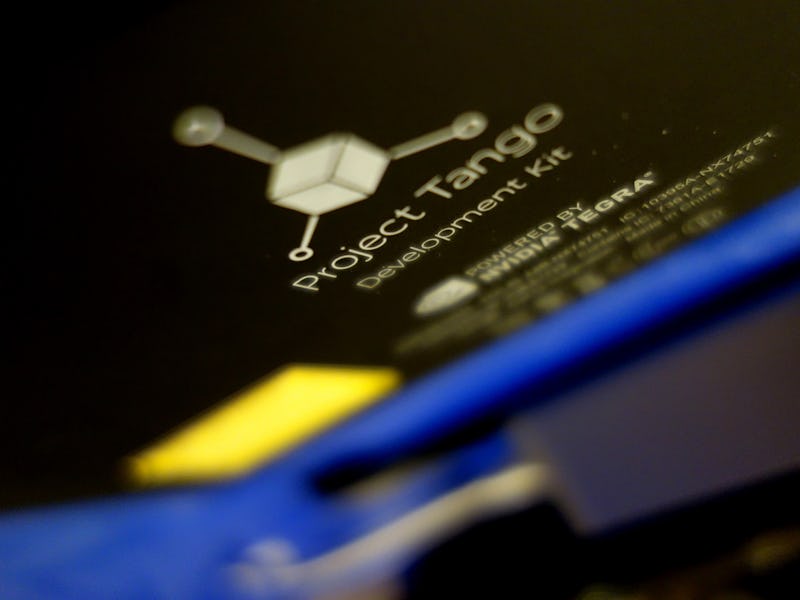What Is Google's Project Tango For? In a Word, Everything.
The environment scanning tech will build virtual reality out of your physical surroundings. And that's just for starters.

Last year, Google unveiled a new project that sounded like a top-secret extraction mission in some 1980s action flick: Project Tango. Google unveils new projects like lonely grandmas dish out candy on Halloween; that is to say, freely, and without much discretion. This project, though, is different — and it’s not just limited to Google. The company has invited the public to figure out the best applications for its technological breakthrough. And frankly? The scope of these potential applications is astounding.
Right now, Project Tango functions on a special tablet or smartphone equipped with an infrared camera, infrared emitter, and a wide-angle lens. Taken together, the triad can map out a room in 3D. The infrared emitter speckles its surroundings with dots, and, combining this information with the other sensors’ information, uses those dots to create a 3D map of any given space.
Google likens the process to the way a human might navigate a foreign environment. You awaken, sitting on a couch, in an unfamiliar room. You open your eyes and scan your surroundings. Your mind, whether you ask it to or not, is mapping the environment. (“I am in the corner of the room. A coffee table is in front of me and a chair and ottoman sit to my left. If I stand up, I’ll need to avoid those objects.”)
Project Tango functions analogously. Your phone or tablet “wakes up” and begins to look around, gathering information about its surroundings. That may not seem all that thrilling or revolutionary, but it is. Imagine not just virtual reality but so-called “mixed reality,” or truly augmented reality: the ability to turn your home, for example, into a virtual amusement park. Developers are already proving that they’re up to the task, creating games that respond to the device’s learned environment.
Since it’s mixed reality, there’s no fear of running full-bore into the nearest wall after donning your VR headset and seeing a virtual ghost. With mixed reality, you’d see the wall, in whatever form the game rendered it. (You’ll still look like a goofball, but such stigmas are bound to change as VR becomes more common.) You’d be able to play a first-person shooter game in your own home or in any mapped room; you’d dodge incoming fire behind your couch and duck into a closet to reload.
You could also use Tango to play games with friends, family, or roommates. You could stash a virtual object on a real, physical object for your friend to find later, or set up a treasure map with clues guiding your younger sibling to the virtual gold under the lampshade in the basement.
Another application: decking out your apartment with virtual furniture, so as to either imagine how cool you could be or, more practically, to preview how the living room would look with the addition of that new couch you’re thinking of buying. Virtual shopping in all forms. The list goes on and on.
Tango devices are able to so function because they are equipped with motion tracking, area learning, and depth perception capabilities. The combination of all three allows the device to create an incredibly accurate 3D map of an area. The infrared sensors have some limitations. For instance, the device will struggle to map bright windows, as sunlight transmits too much infrared and confuses the sensors. Still, despite such early-phase limitations, the results are still unlike anything you’ve ever seen.
But take the speculation to the big picture and your head may start spinning. Google could maintain a database that holds 3D maps of public spaces: streets, bike lanes, libraries, and so on. (Think Street View, but way more badass.) This information could then be used to further the navigational capacities of self-driving cars. The technology could assist visually impaired people with a form of sonar. It could also allow for major breakthroughs in robotics: As better robots are developed, they’ll be able to come prepackaged with knowledge of their surroundings — and the ability to discover and react to any changes. NASA is among many who, for this reason, are intrigued. One can imagine a grocery store that receives your list and creates a map for you to follow, in real time, of the most efficient route to each item. (If not that, you’ll at least be able to keep your kids both entertained and distracted as you finish up the shopping.)
Where there’s much to anticipate, there can also be cause for concerns. So, too, with Tango — all this data would be considered quite valuable by intrusive minds, organizations, and agencies. Imagine the possibilities for law enforcement agencies allowed to access the scans of a citizen’s home; or, by the same coin, would-be thieves who hack such data to case a room for valuables. The progression of the technology will be fascinating to witness, but so too will the progression of the policies defining the privacy and security of its users.
But when robots, space, and in-home mixed-reality shooter games are on the line, bring on the future. And these applications are actually just the tip of the proverbial iceberg. Project Tango is limited by your imagination. Given the technology’s capacities, what application would you dream up? Find a developer and make it happen.